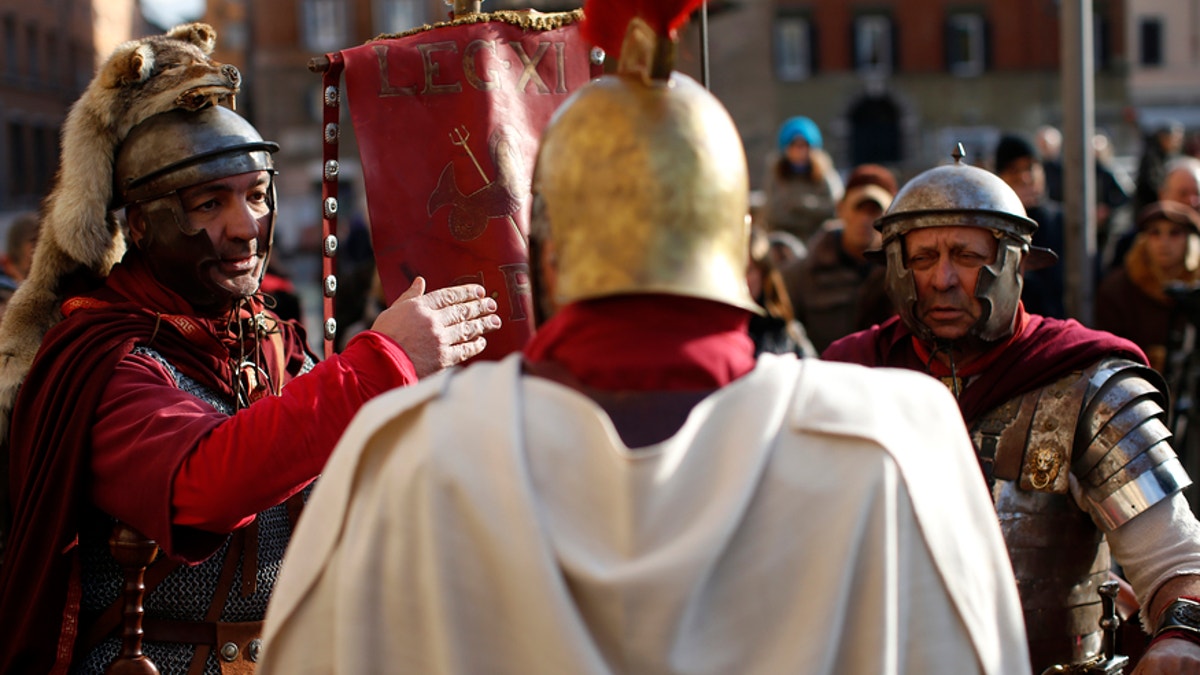
Members of Roman historical society "Gruppo Storico Romano" talk before taking part in a re-enactment of the "Ides of March", known also as the date on which Julius Caesar was assassinated in 44 BC, in downtown Rome. (REUTERS/Tony Gentile)
It's a warning that has been echoed on stages across the globe for centuries: "Cave Idus Martiae" or "Beware the Ides of March."
William Shakespeare coined the phrase in his tragedy “Julius Caesar."
According to the play, a fortune-teller whispered the words to Caesar, the dictator of the Roman empire, before he was assassinated -- stabbed 23 times by a group of his own senators led by brothers-in-law Cassius and Brutus in 44 B.C.
"Not only did Shakespeare’s words stick, they branded the phrase with a dark and gloomy connotation that will forever make people uncomfortable," History.com said in a post online. "The great poet...could not have imagined the life it's taken on the 500 years since."
Shakespeare may be the reason why the line is famous today, but the Ides of March -- a date on the Roman calendar that coincides with March 15 -- has been significant long before Shakespeare's early 1600s play.
What does 'Ides of March' mean?
To ancient Romans, "Ides" translated to "middle." So the phrase actually means "middle of the month," which falls on the 15th day of the month in March, May, July and October and the 13th day of the other months.
What occasion did the Ides of March initially mark?
The Ides was used to mark the first full moon of the month.
In the olden days, the Roman calendar was divided into three parts -- the "Calends," "Nones" and "Ides" -- to identify special lunar events.
The "Calends" signified the "start of the new moon cycle" on the first day of the month, according to online calendar Time and Date. "Nones" came next, about a week into a new month, to mark the half moon. Lastly, "Ides" marked the full moon.
"Each day was referred to by how many days it fell before the Calends, Nones or Ides. For example, March 11 would be known as “Five Ides” to the Romans because it is four days before the Ides of March (March 15)," Time and Date reports.
What else?
In the U.S., the Ides of March used to indicate Tax Day.
From 1918 to 1954, Tax Day fell on March 15. Congress moved the date up a month -- to April 15 -- in 1955 to "give IRS employees a break," according to the Tax History Project, a website set up more than 20 years ago by tax analysts that provides information on the history of American finance. It has remained that date ever since.
What happened to Caesar?
As previously mentioned, March 15 marks the death of Caesar. The brutal murder was reenacted in Act 1, Scene 2 of Shakespeare's iconic tragedy.
Caesar was assassinated by as many as 60 men in a meeting hall next to Pompey’s Theatre, where the Roman citizen army reportedly gathered before marching to battle.
"Caesar was scheduled to leave Rome to fight in a war on March 18 and had appointed loyal members of his army to rule the Empire in his absence," History.com explains. "The Republican senators, already chafing at having to abide by Caesar’s decrees, were particularly angry about the prospect of taking orders from Caesar’s underlings."
Roman Senator Cassius concluded the only way to rid Caesar of his power over the Roman people was to kill him. He came up with the murder plot and enlisted Brutus, Caesar's trusted protégé and friend, to assist him with the execution.
Hence, in the play, Caesar's famous last words were, “Et tu, Brute?” or "And you, Brutus?" surprised his friend was taking a role in the act.
What are people saying about the Ides of March?
The hashtag #IdesOfMarch began trending early March 15, with several well-known organizations commenting on the date.
"'Beware the Ides of March' (Act 1, Scene 2). #Onthisday (15 March) in 44 BC, #JuliusCaesar was murdered, stabbed 23 times by a group led by Cassius and Brutus," Shakespeare's Globe tweeted, with a sarcastic meme attached.
The Globe followed-up the tweet with a photo of a bottle of Caesar dressing being stabbed with a knife.
"Beware the Ides of March! Julius Caesar was assassinated #onthisday in 44 BC. This coin was issued by his betrayer Brutus," the British Museum in London tweeted, along with knife emojis.
The Museum of Fine Arts in Boston shared a picture of a special coin, explaining, "Julius #Caesar was assassinated by his own senators #onthisday in 44 B.C. This coin commemorates the act, with a portrait of #Brutus on the front and "Eid Mar," or #IdesOfMarch, emblazoned on the back along with two daggers and a liberty cap."
